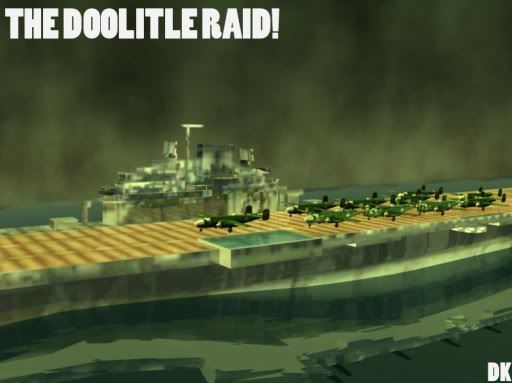You are using an out of date browser. It may not display this or other websites correctly.
You should upgrade or use an alternative browser.
You should upgrade or use an alternative browser.
Dutchking's Productions
- Thread starter dutchking
- Start date
dutchking
Deity
- Joined
- Apr 30, 2007
- Messages
- 3,317
http://forums.civfanatics.com/downloads.php?do=file&id=9111
I made a Doolittle Raid "stationary object". If anyone cares.

(first REAL 3D render too btw.)
I made a Doolittle Raid "stationary object". If anyone cares.


(first REAL 3D render too btw.)
Gaius Octavius
Deity
- Joined
- Jul 28, 2006
- Messages
- 4,016
I made a Doolittle Raid "stationary object". If anyone cares.
I do!

Incidentally, the Hornet was not an Essex-class carrier, but a Yorktown-class. However, we don't have a Yorktown graphic presently.

dutchking
Deity
- Joined
- Apr 30, 2007
- Messages
- 3,317
You sure about that GO?
Looks good enough. Like the render?
I guess they're similar or something. *shrugs*wiki said:The preceding Yorktown-class carriers formed the basis from which the Essex class was developed. Designed to carry a larger air group, and unencumbered by pre-war naval treaty limits, the USS Essex (CV-9) was over sixty feet longer, nearly ten feet wider in beam and more than a third heavier. A longer, wider flight deck and a deck-edge elevator facilitated more efficient aviation operations, enhancing the ship's offensive and defensive air power. Machinery arrangement and armor protection was greatly improved from previous designs. These features, plus the provision of more anti-aircraft guns, gave the ships much enhanced survivability. In fact, none of the Essex-class carriers were lost and two of them, Franklin (CV-13) and Bunker Hill (CV-17), came home under their own power even after receiving heavy damage.
Looks good enough. Like the render?

Wolfshanze
CFC Historian
They're NOT the same class DK... it is what it is... they are differant carriers.
I really don't care, but don't try and justify that there's no differance between a Yorktown and Essex class carrier... Gaius is right.
I really don't care, but don't try and justify that there's no differance between a Yorktown and Essex class carrier... Gaius is right.
asioasioasio
Fallout Scrubber
Very nice render .
I love the composition and the colors
I love the composition and the colors

dutchking
Deity
- Joined
- Apr 30, 2007
- Messages
- 3,317
Thanks asio. 
Wouldn't been able to do it without the inspiration of those tutorials you sent me. (www.colacola.se)
(www.colacola.se)

Wouldn't been able to do it without the inspiration of those tutorials you sent me.
 (www.colacola.se)
(www.colacola.se)asioasioasio
Fallout Scrubber
 Yeah tutorials are great - it helps to learn new things faster
Yeah tutorials are great - it helps to learn new things faster 
Gaius Octavius
Deity
- Joined
- Jul 28, 2006
- Messages
- 4,016
I really don't care, but don't try and justify that there's no differance between a Yorktown and Essex class carrier... Gaius is right.
Yeash, for a change.
 You could probably get away with a reskin of the Essex carrier though.
You could probably get away with a reskin of the Essex carrier though.

Wolfshanze
CFC Historian
Yeah, well Smitty neglected to release his WWI artillery before he took off for the sandbox! 

GeoModder
Deity
- Joined
- Nov 29, 2005
- Messages
- 7,512
Where did he go?
AFAIK, nothing was said publically. He did mention 'going to war' though, so that's a good hint to where he went.

Wolfshanze
CFC Historian
Well, if you want to do tanks, there are still holes (especially with Smitty gone, he can't claim "he's working on them").
There's no Italian/Roman heavy tank...
Answer: CA P26/40
There's no Japanese heavy tank...
Answer: Type 3 Chi-Nu
There's no Hungarian tanks...
Answer: Turan I and/or Turan II
There's no Swedish/Viking tanks...
Answer: Strv M38 / M40 / M42
I'm more then willing to offer better pictures/more info on any of the above vehicles for anyone who takes-up the gauntlet.
There's no Italian/Roman heavy tank...
Answer: CA P26/40
There's no Japanese heavy tank...
Answer: Type 3 Chi-Nu
There's no Hungarian tanks...
Answer: Turan I and/or Turan II
There's no Swedish/Viking tanks...
Answer: Strv M38 / M40 / M42
I'm more then willing to offer better pictures/more info on any of the above vehicles for anyone who takes-up the gauntlet.
Similar threads
- Replies
- 16
- Views
- 1K
- Replies
- 5
- Views
- 155


 A link to all of my good units are in my sig.
A link to all of my good units are in my sig. 
 Plus some artillery, maybe some tanks.
Plus some artillery, maybe some tanks.